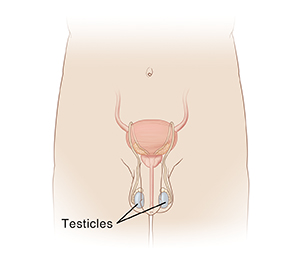Radical Orchiectomy
Radical orchiectomy is surgery to remove a testicle. It’s most often done to treat testicular cancer. Or it may be needed if a testicle is severely damaged due to infection or injury. Some forms of treatment for prostate cancer include orchiectomy. The penis is not affected by the surgery. The sac of skin that holds the testicles (scrotum) also stays the same after surgery.

Changes in your body
Having a testicle removed can affect how you feel about your body. It may help to talk with a mental health provider before or after the procedure. In some cases, an artificial testicle (prosthesis) can be placed during surgery or at a later time. You and your healthcare provider can discuss if this is an option for you. Having a testicle removed could affect your ability to have children (fertility). If you want to have children, you may choose to store sperm before the procedure as a safety measure. Talk with your provider about this.
Getting ready for surgery
Prepare for the surgery as you have been told. In addition:
-
Tell your healthcare provider about all medicines you take. This includes over-the-counter and prescription medicines, vitamins, herbs, and other supplements. It also includes any blood thinners, such as warfarin, clopidogrel, or daily aspirin. You may need to stop taking some or all of them before surgery.
-
Follow any directions you are given for not eating or drinking before your surgery. (If you have been instructed to take medicines, take them with a small sip of water.
The day of surgery
The surgery takes about 1 hour. You may go home the same day. Or you may spend one or more nights in the hospital.
Before the surgery begins
-
An IV (intravenous) line is put into a vein in your arm or hand. This line delivers fluids and medicines (such as antibiotics).
-
You may be given medicine to prevent blood clots.
-
To keep you pain-free during the surgery, you may be given general anesthesia. This medicine puts you into a deep sleep-like state through the surgery. A tube may be put into your throat to help you breathe. Spinal anesthesia and local anesthesia are also options. You can talk about these options with the anesthesiologist or nurse anesthetist.
During the surgery
-
A cut (incision) is made in the groin.
-
The testicle is removed. In cases of testicular cancer, the spermatic cord may also be removed. This structure contains nerves, arteries, and a tube that carries sperm away from the testicle.
-
When the surgery is done, the incision is closed with stitches or staples. These may need to be removed by the healthcare provider at a follow-up visit.
After the surgery
You will be taken to the post anesthesia care unit (PACU) to be closely monitored as you wake up from the anesthesia. You may feel sleepy and nauseated. If a breathing tube was used, your throat may be sore at first. An ice pack may be placed on the surgical area. This helps reduce swelling. You may also be given a jockstrap to wear. This helps ease pain and swelling, and prevents injury. Once you are ready to go home, have a responsible adult family member or friend drive you.
Recovering at home
Follow the instructions you have been given to care for yourself. During your recovery:
-
To help reduce swelling, put an ice pack or cold compress on the scrotum as directed. Do this for no longer than 15 minutes at a time. Keep using the cold pack for 3 days, or until swelling improves. To make an ice pack, put ice cubes in a plastic bag that seals at the top. Wrap the bag in a clean, thin towel or cloth. Never put ice or an ice pack right on the skin.
-
Take prescribed pain medicine as directed.
-
Care for your incision as instructed. Check the incision daily for signs of infection (listed below).
-
Follow your healthcare provider’s guidelines for showering. Don't swim, bathe, use a hot tub, or do other things that will cover the incision with water until your provider says it’s OK.
-
Wear a jockstrap or snug underwear as directed.
-
Don't do heavy lifting and strenuous exercise as directed.
-
Don't have sex for 4 weeks.
-
Don't drive until you are no longer taking pain medicine and your healthcare provider says it’s OK.
When to call your healthcare provider
Call your healthcare provider right away if you have any of the following:
-
Fever of 100.4° F ( 38°C ) or higher, or as directed by your provider
-
Symptoms of infection at the incision site such as:
-
More redness or swelling
-
Warmth
-
Pain that gets worse
-
Bad-smelling drainage
-
More pain or swelling in the scrotum or groin area
-
Pain that is not eased by pain medicine
Call 911
Call 911right away if you have:
-
Chest pain
-
Trouble breathing
Follow-up care
You will have follow-up visits so your healthcare provider can check on your healing. Stitches or staples may need to be removed. You and your provider can also talk about any further treatments you may need.
Risks and possible complications
All procedures have risks. Some possible risks of this procedure include:
-
Bleeding (may require a blood transfusion)
-
Infection
-
Damage to nearby nerves, blood vessels, soft tissues, and organs
-
Infertility
-
Changes in hormone levels
-
Cancer comes back or it spreads
-
Risks of anesthesia (the anesthesiologist or nurse anesthetist will talk about these with you)
Online Medical Reviewer:
Marc Greenstein MD
Online Medical Reviewer:
Raymond Kent Turley BSN MSN RN
Online Medical Reviewer:
Rita Sather RN
Date Last Reviewed:
12/1/2022
© 2000-2024 The StayWell Company, LLC. All rights reserved. This information is not intended as a substitute for professional medical care. Always follow your healthcare professional's instructions.